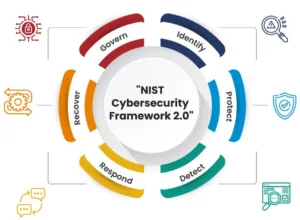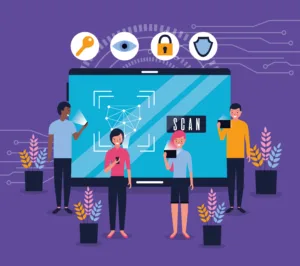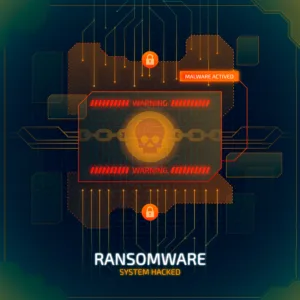
Table of Contents
In the ever-evolving landscape of cybersecurity, the year 2024 is poised to bring a new set of challenges, with the ominous shadow of AI-enhanced scams looming on the horizon. As we gaze into the cyber crystal ball, the convergence of artificial intelligence and cyber threats paints a picture of heightened risks and sophisticated challenges that individuals and organizations must brace for.
In this post, we’ll delve into the unfolding narrative of AI-enhanced scams, exploring the imminent cybersecurity challenges and strategies to navigate this complex terrain.
The Rise of the Machines: AI-Enhanced Cyber Scams
Artificial intelligence, once a beacon of innovation, is now taking on a darker hue as cybercriminals harness its power for malicious intent. The integration of AI in cyber attacks amplifies their scale, speed, and precision. From phishing to ransomware, AI is becoming the cybercriminal’s accomplice, enabling attacks that are more sophisticated and difficult to detect.
In 2024, we can expect an upswing in AI-enhanced scams, where machine learning algorithms are employed to craft convincing phishing emails, replicate user behavior for identity theft, and even generate lifelike voice patterns for fraudulent calls. The cyber threat landscape is evolving, and the arsenal of cybercriminals is growing more sophisticated with each passing day.
The Perfect Storm: AI-Enhanced Phishing Attacks
Phishing attacks, a perennial cybersecurity concern, are poised to reach new heights in 2024 with the infusion of AI. Imagine receiving an email that not only mimics the writing style of a trusted colleague but also adapts its content based on your recent online activities.
AI algorithms can analyze vast datasets to craft personalized and convincing phishing messages, making it increasingly challenging for users to discern the authentic from the malicious.
AI-enhanced phishing attacks will likely exploit psychological triggers, leveraging insights into individual preferences, interests, and online behavior. The days of generic phishing emails with obvious red flags may soon be behind us, replaced by tailored messages that exploit our trust and familiarity.
Deep fakes and Voice Cloning: A New Frontier in Social Engineering
As we advance into 2024, the realm of social engineering is set to undergo a transformative shift with the rise of deepfake technology and voice cloning. Deepfakes, AI-generated hyper-realistic videos, can manipulate visual content to make it appear as though individuals are saying or doing things they never did. Similarly, voice cloning can recreate a person’s voice with remarkable accuracy, making it indistinguishable from the real thing.
In the context of cybersecurity, these technologies pose a significant threat. Cybercriminals could use deep fakes to create fraudulent video messages, manipulating the perception of reality. Voice cloning, on the other hand, opens the door to AI-driven impersonation in phone calls or audio messages, adding a new layer of sophistication to social engineering attacks.
The Human Element: Cybersecurity Risks in an AI-Driven World
As AI-enhanced scams become more prevalent, the human element in cybersecurity becomes both the first line of defense and a potential vulnerability. The personalized nature of AI-driven attacks makes it crucial for individuals to remain vigilant and skeptical of unexpected messages or requests, even if they appear to be from familiar sources.
Furthermore, organizations must prioritize cybersecurity training to educate employees about the evolving tactics employed by cybercriminals. Recognizing the signs of AI-enhanced scams, understanding the risks, and adopting a proactive stance are essential components of safeguarding against the looming cyber threats.
Defending Against the Onslaught: Cybersecurity Strategies for 2024
In the face of the impending storm of AI-enhanced scams, adopting robust cybersecurity strategies is imperative. Here are key considerations for individuals and organizations looking to bolster their defenses:
1. Continuous Education and Awareness:
Keeping abreast of the latest cyber threats and understanding the tactics employed by cybercriminals is crucial. Regular cybersecurity training and awareness programs can empower individuals to recognize and respond to emerging threats effectively.
2. Advanced Authentication Measures:
As traditional authentication methods become more susceptible to AI-driven attacks, the adoption of advanced authentication measures such as biometrics, multi-factor authentication, and behavioral analytics becomes essential. These measures add layers of security that are more resistant to manipulation by AI algorithms.
3. AI-Powered Security Solutions:
In the battle against AI-driven threats, organizations can leverage AI-powered security solutions. These solutions use machine learning algorithms to analyze network behavior, detect anomalies, and identify potential threats in real time. The use of AI in cybersecurity can enhance the speed and accuracy of threat detection and response.
4. Collaboration and Information Sharing:
Cyber threats are not isolated incidents; they often target multiple entities simultaneously. Collaborative efforts and information sharing among organizations, industries, and even nations can strengthen collective cybersecurity defenses. The more we know about emerging threats, the better equipped we are to defend against them.
5. Regular Security Audits and Updates:
Cybersecurity is an ever-changing landscape, and regular security audits are essential to identify and address vulnerabilities. Keeping software and systems up to date with the latest security patches is a fundamental practice that can mitigate the risk of exploitation by cybercriminals.
Conclusion: Navigating the AI-Enhanced Cyber Frontier
As we peer into the cyber crystal ball of 2024, the convergence of AI and cyber threats presents a formidable challenge. The looming threat of AI-enhanced scams requires a proactive and adaptive approach to cybersecurity.
By staying informed, embracing advanced authentication measures, leveraging AI-powered security solutions, fostering collaboration, and conducting regular security audits, individuals and organizations can navigate the evolving landscape of cyber risks and emerge stronger on the other side.
The future of cybersecurity is intricately tied to our ability to understand, anticipate, and effectively counteract the threats posed by AI-enhanced scams. In this digital age, where the line between reality and deception is increasingly thin, the resilience of our cybersecurity defenses will determine our collective ability to safeguard the integrity of the digital realm.
Let us face the challenges of 2024 with vigilance, knowledge, and a commitment to securing the interconnected world we inhabit.
Read more on https://cybertechworld.co.in for insightful cybersecurity related content.




















Thanks for sharing. I read many of your blog posts, cool, your blog is very good.